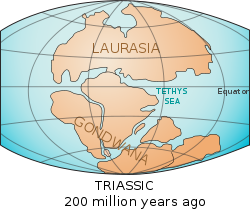During the
Jurassic Period (150
Ma), Cimmeria finally
collided with Laurasia. There it stalled, the ocean floor behind it
subducting under, forming
the
Tethyan Trench. Water
levels rose and the western Tethys came to shallowly cover significant
portions of Europe, forming the (first) Tethys Sea. Around the same time,
Laurasia and Gondwana began drifting apart, opening an extension of the
Tethys Sea between them that today is the part of the Atlantic Ocean between
the Mediterranean and
Caribbean. As North and
South America were still attached to the rest of Laurasia and Gondwana,
respectively, the Tethys Ocean in its widest extension was part of a
continuous oceanic belt running around the Earth between about latitude 30° N and the
Equator. Thus, ocean currents at that
time – around the Early Cretaceous – ran
radically differently from the way they do today.
Between the
Jurassic and the Late Cretaceous (which
started about 100 Ma), Gondwana began breaking up, pushing Africa and India north, across the
Tethys and opening up the Indian Ocean. As these
land masses pushed in on it from all sides, up until as recently as the
Late Miocene (15 Ma),
the Tethys ocean continued to shrink, becoming the Tethys Seaway or (second)
'Tethys Sea'.
Today,
India, Indonesia and the
Indian Ocean cover the
area once occupied by the Tethys Ocean, and Turkey, Iraq, and Tibet sit on Cimmeria.
What was once the Tethys Sea has become the Mediterranean Sea.
Other remnants are the Black, Caspian and
Aral Seas (via a former
inland branch known as the
Paratethys). Most of
the floor of the Tethys Ocean disappeared under Cimmeria and Laurasia.
Geologists
have found fossils of ocean
creatures in rocks in the Himalayas, indicating
that those rocks were once underwater, before the Indian continental shelf
began pushing upward as it
smashed into Cimmeria. We can see similar geologic evidence in the
Alpine orogeny of
Europe, where the
movement of the
African plate raised
the
Alps.
Paleontologists also
find the Tethys Ocean particularly important because much of the world's sea
shelves were found around its margins for such an extensive period of time.
Marine, marsh-dwelling, and
estuarian fossils from
these shelves are of considerable paleontological interest.
Like every
science, geology is a
continuously evolving system of theories,
and the terms used to describe various pre-historic formations have
fluctuated as more accurate theories have emerged. For example, many
internet sources use "Tethys Ocean" to refer to the "Tethys Sea" and vice
versa. Some even appear to erroneously refer to the growing
Atlantic Ocean during the
Jurassic as the Tethys Sea.
The western part of the Tethys Ocean is called Tethys
Sea, Western Tethys Ocean or Alpine Tethys Ocean. The Black,
Caspian
and Aral
Seas are thought to be its
crustal remains (though the Black Sea may in
fact be a remnant of the older
Paleo-Tethys Ocean).
However, this "Western Tethys" was not simply a single open ocean. It
covered many small plates,
Cretaceous
island arcs and
microcontinents. Many small oceanic
basins (Valais
Ocean,
Piemont-Liguria Ocean,
Meliata ocean) were
separated from each other by continental
terranes
on the
Alboran,
Iberian, and
Apulian plates. The high sea level
in the Mesozoic age flooded
most of these continental domains forming shallow seas.
During the
Oligocene, large parts of central and
eastern Europe were covered by a northern branch of the Tethys Ocean, called
the
Paratethys. The
Paratethys was separated from the Tethys by the formation of the Alps,
Carpathians,
Dinarides,
Taurus and
Elburz
mountains during the
Alpine orogeny. It gradually disappeared
during the late Miocene, becoming an isolated inland sea.
The eastern part of the Tethys Ocean is likewise sometimes referred to as
Eastern Tethys.
As theories have improved, scientists have extended the
"Tethys" name to refer to similar oceans that preceded it. The
Paleo-Tethys Ocean,
mentioned above, existed from the
Silurian (440 Ma) through the
Jurassic eras, between the
Hunic terranes and
Gondwana (later the
Cimmerian terranes). Before that, the
Proto-Tethys Ocean
existed from the
Ediacaran (600 Ma) into
the Devonian (360 Ma), and
was situated between Baltica and
Laurentia to the north and
Gondwana to the south. Neither Tethys oceans
should be confused with the
Rheic Ocean, which existed to the west of
them in the Silurian era.
End of
Reading
Return to the
Old Earth Ministries Online Earth
History Curriculum homepage.

Source Page:
Tethys
Ocean
